Introduction:
I personally choose to conduct this particular research due to my own interest. I am a Vietnamese who used to live in the Tenderloin neighborhood, I learned how people there lived, I also ate and drank with them as well as I communicated with them almost every day. Day in and day out I familiarized myself with the community enough to listen to and sympathize with their own stories. I realized there is a tremendous need for the variety of community economic development projects, particularly for Vietnamese community in the Tenderloin. I have been doing this research as one of my passions and I wanted to contribute myself to the economic development projects in the Tenderloin, and the objective of the research is to focus on the Vietnamese community. (Chinese- Vietnamese).
Having my idea of conducting a scientific research exposed to Executive Path, a non-profit academic and scientific organization in San Francisco, I got approved and supported in order to get this research done. This is also a precious opportunity to get my research conducted more efficiently as Executive Path has already had plenty of experiences in researches as well as has many connections with other non-profit organizations such as Tenderloin Economic Development Projects, in which I can get specific data.
In this research, I investigated the community as much as possible, concurrently I joined in many events and meet ups related to Tenderloin development and collected newspaper and magazine articles concerning the Tenderloin community and the Vietnamese (or Chinese-Vietnamese) in particular. I focus on getting deep insights into Vietnamese community in terms of lifestyle, career & income, education and culture. The key purpose is to understand them, then observe the efficiency of approaching methods to improve the community in Tenderloin in a different and better way. According to The Bedrock of Community Development, Dunbar said,
―Community development work starts with the people—involves the people—and ends with the people. It is they who must get together to create the next unit of community development.‖ In my point of view, people living in Tenderloin can change their own community, and whether or not Tenderloin can be promoted is to rely on its communities.
Background:
According to the 2010 census, nearly 13,000 Vietnamese are living in San Francisco, a relatively small number compared with 100,000 ones at San Jose. The census does not mention the Tenderloin, but Philip Nguyen, Executive Director of Southeast Asian Community Center estimates there are around 3,500 Vietnamese in the Tenderloin. The small community has made remarkably contributions to the neighborhood development, including Vietnamese cultural celebrations such as the Tet Festival, the Vietnamese Lunar New Year celebration and the majority of Vietnamese restaurants here. However, the majority of grants from the Government and nonprofit organizations generally support Tenderloin in terms of health and safety of the residents without concentration on each community based on its potential development.
This research leads to the recommendation that the Government, non-profit organizations and community organizations have deep insights into the Vietnamese community in the Tenderloin neighborhood. By this way, they can think over its tangible and intangible values as well as explore the potential development of each local community, particularly Vietnamese community in Tenderloin in order to leverage it instead. It is considered as a new idea of the change in supports for Tenderloin.
This independent research was conducted under the supervision of Mr. Michael Pacheco, founder of the non-profit scientific organization Executive Path Inc., located in the city of San Francisco in the State of California.
This research is intended to serve non-profit organizations, foundations and Tenderloin economic development projects which are attempting to make a significant positive impact on the Tenderloin. In this particular research, I used the qualitative approach with the combination methods to provide a specific review on the development of the Vietnamese Tenderloin.
ACKNOWLEDGEMENT
Many contributions went into the making of this research. Personally I owes thanks to the following individuals and organizations:
The members of Executive Path Inc., the sponsor organization, for the research guidance and project events collaboration;
The members of Tenderloin Economic Development Project, for the support of information;
Mr. Michael Pacheco, Chief Executive Officer of Executive Path Inc., research instructor, for sharing his precious time and positive insight into this independent research;
Ms. Thanh Ngo, Marketing analyst of Executive Path Inc., research advisor and coordinator, for specific guidance and immediate support;
Ms. Anh Nguyen, Executive Director of the Tenderloin Economic Development Projects, for specific information and data;
Vietnamese community in Tenderloin in general and at St. Boniface church in particular for supports during the time the research was conducted.
METHODOLOGY
Phase 1: Collect opinions/ rating from randomly chosen people, those are Vietnamese living in the Tenderloin neighborhood to get raw data for compilation to get to discussion and conclusion. This will be carried out by the method of face-to-face and email surveying. The questionnaire form is used for survey is a combination of the rating questions in terms of housing, career, education and culture. Information collected is gathered and converted into the form of data and reflects on the chart.
Phase 2: Collect information concerning the Vietnamese through newspaper, magazines and online website to add more specific data.
Phase 3: Collect information relating to Tenderloin Economic Development Projects by participating in the meet ups and workshops hosted by Tenderloin community organizations. Observing and evaluating information during the conversations between professionals and attendants. Review the results collected from each meet up and workshop to make conclusion.
Phase 4: Obtain data and analyze the information.
DISCUSSION AND RESULTS
I. The Tenderloin background
First of all, there were many stories about how the Tenderloin got its name. Some said it was named either after an older neighborhood in New York with the same name and similar characteristics or after the neighborhood as the ―soft underbelly‖ of the city, with allusions to vice and corruption, especially graft. Another was the words of a New York City police caption, Alexander S. Williams, who was assigned to another part of the city, he could only afford to eat chuck steak on the salary he was earning, but after he was transferred to this neighborhood he was making so much money on the side soliciting bribes that now he could eat tenderloin instead. Another version of that story said that the officers who worked in the Tenderloin received a ‘hazard pay’ bonus for working in such a violent area, and thus were able to afford the good cut of meat. (Lillan Smith, Wikipedia)
According to the latest online surveys, the Tenderloin covers 56 blocks approximately framed by Market, Geary, Van Ness and Powell streets. The Tenderloin is the poorest neighborhood and has highest crime rate of any district in San Francisco for decades because of the highest concentration of drug dealing and drunks, prostitution, the homeless and mentally ill, troubled veterans, and impoverished new immigrants. Here, there are crowded immigrant families working very hard to make a life for themselves. In the old hotels along the streets of Leavenworth or Eddy, a family of five can squeeze into one small room. They almost have no more choices better than living here, because rents are cheaper than elsewhere in San Francisco. Moreover, jobless people and the homeless are more likely to gather here to rely on the variety of supports from many non-profit organizations located in the Tenderloin.
The map below shows the boundaries of the Tenderloin as well as the street names throughout the neighborhood as geographic reference points.
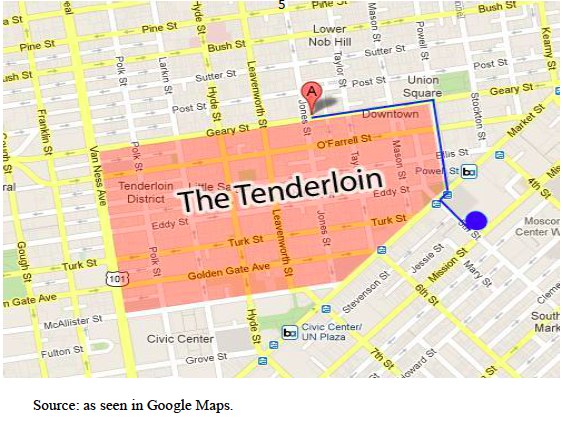
According to the census 2010, there are about 31,565 people living in single-room occupancy hotels and dingy apartments in the Tenderloin. The neighborhood’s density includes 32% of White, 28% of Asian, 24% of Hispanic, 11% of Black and 5% of Others.
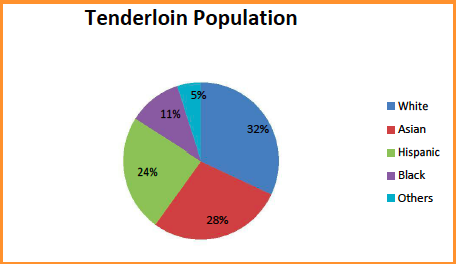
Among 28% of Asian is nearly 40% of the Vietnamese or Chinese- Vietnamese. Almost of the Vietnamese entered into the U.S were immigrations. The first large migration of Vietnamese into the U.S came in the 1970s after the fall of Saigon in 1975. The second one consisted of a group of people who have been labeled the ―boat people‖. Most of these
Vietnamese immigrants are ethnic Chinese. They were attracted to the Tenderloin areas by its low rents and high rates of tenant turnover. Although Vietnamese community is a small part of the Tenderloin, their presences have given the Tenderloin community respectability and a voice in city hall.
In fact, the Tenderloin in San Francisco has been referred to as ―Little Saigon‖, a well-known name for Vietnamese community found in the whole U.S. According to Kim Nguyen, project manager of the Little Saigon Project Task Force, a coalition of community organizations and institutions that lobbied for the name said that “Everyone knows if you want something Vietnamese, you come to the Tenderloin‖. This shows that Vietnamese community is a significant part of the community as well as makes the Tenderloin neighborhood recognized following the name ―Little Saigon
II. The Vietnamese housing
With the development of the whole San Francisco, many areas of the city are upgraded but the Tenderloin community has not much change, particularly the Vietnamese. There are still many families including parents and children, even grand-parents living in the crappy one-bedroom or a small studio. Some dingy apartments on Leavenworth and Eddy Street such as K&H hotel try to separate rooms as much as possible to increase rents. There has no kitchen, bathroom and restroom in each room. They have to share bathrooms and restrooms together, around 5 separated rooms for one bathroom & restroom in average. They have to squeeze everything to save up the space for a tiny kitchen with a simple microwave, cooker and stove. And of course, they have no personal freedom space for each individual.
An interview was made by 60 people over 18 years old (able to live independently) who are living inside these departments on Eddy St. There are two groups of people (30 for each) to be asked, one is in the range of 18-55 years old who can find a job and the rest is over 55 years olds as retired ones.
They were asked to complete a survey to answer the question regarding their main reasons to live in such under conditioned places. Almost people listed out some popular reasons: ―save money‖, ―nearby the downtown‖ (convenient movement) considered the same as ―have no car‖, ―get more supports from non-profit services centered here‖, ―concentration of Vietnamese community‖ and others. The chart shows the percent rate of people giving the reasons to live in the Tenderloin.
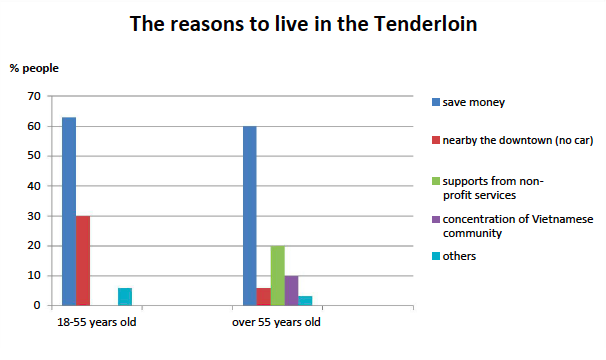
As shown on the chart, there are significantly different reasons between the two groups. Among 30 people in the range of 18-55 years old, 19 people choose to live in the Tenderloin because of its cheap rents and they can save a lot of money, 9 people feel more convenient to live nearby the downtown and 2 people have other personal reasons. While 18 people over 55 years old also want to save money, only 2 people love living nearby the downtown, 6 people live here for getting supports from non-profit services such as free food, 3 people want to live closely to Vietnamese community and only one is for other personal reason. As the result, the main reason for the two groups to choose live in the Tenderloin is ―save money‖.
However, the neighborhoods demographics are changing that many younger people with middle-income are more likely to move to safer and cleaner places. They move out of the city to where ―they think their social status will be better off. And they understandably want a larger house for an expanding family,‖ says Philip Nguyen, director of the Southeast Asia Community Center. This is not exceptional for the younger Vietnamese. According to John Nguyen, the only Vietnamese member of the Tenderloin Community Benefits District board said that he felt
Tenderloin’s Vietnamese population is shrinking, particularly at the church in which he and his wife often join Vietnamese language Mass for the Sunday afternoon since he was 16 years old. He called it as a crisis. ―Young people don’t come to the Vietnamese service anymore. They want the English one as part of their assimilation. And the old people are dying off.‖ He says.
But there is always one thing which might not change is the Tenderloin is home of the homelessness and drudgers because of its cheapest rent and the concentration of non-profit services.
III. The Vietnamese career and income
The Tenderloin neighborhood is recognized in San Francisco not only for the concentration of drug dealing, drunks, prostitution, the homeless & mentally ill and dirty streets, but also for the name ―Little Saigon‖, where many Vietnamese –American businesses and restaurants are located.
Kim Nguyen, project manager of the Little Saigon Project Task Force said that “People from outside the community know the businesses are here. We have tailors, dentists, travel agents, jewelers, restaurants, acupuncturists, doctor’s offices‖. In fact, according to the latest research, there are more 250 Vietnamese American-owned businesses in the Tenderloin. Almost of which gather on the two blocks of Larkin, as well-known as ―Little Saigon‖. (80% of the businesses here are owned by Vietnamese Americans.)
According to the survey and interview was made by random 100 Vietnamese people over 25 years old living in the Tenderloin and being old enough to get out to work. They were asked to answer the question regarding what their current jobs. The chart below shows the rate of different jobs the Vietnamese are doing.
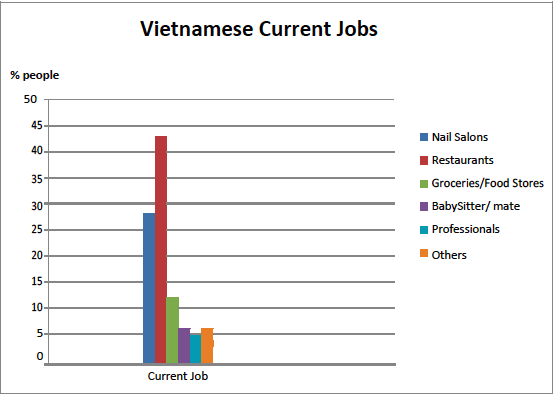
Based on the survey, there are 28 % of people working for and being owners of nail salons, 43% are in restaurants, 12% are in groceries or food stores, 6% work as babysitters or mates who are women in the range of 40-60 years old. Only 5% are working as professionals in different fields in terms of technology, business and art. They are all young people in the range of 25 – 35 years old. The rest 6% work regarding hotel and public services. Although the Vietnamese is famous for nail salon in the whole U.S, in the Tenderloin there are not many nail salons, but restaurants and people have no idea for the reason.
Whichever businesses they are doing, their presences are the life blood for Tenderloin that has been changing the community’s physical appearances. Among such businesses more popularly are groceries, food stores and restaurants which provide the variety of products and goods to the local residents. They no longer need to walk far to buy their essential stuff. Instead, they can easily find some stories on the same street every block. Especially, the majority of the
Vietnamese restaurants locate on Larkin St in the ―Little Saigon‖. This attracts a lot of other neighborhoods and tourists to visit it whenever they want to enjoy the true Asian cuisine or Vietnamese cuisine. As a result, these businesses play a significant role in the growth of the Tenderloin community. Without their businesses, Tenderloin would be more likely to be a waste land, and there is no one who wants to pass by it due to the unsafe areas.
Also the survey did not call out their income, but the information they shared clearly enough to be recognized that almost of their income is low. Only 5% of professionals just start on middle-income. Back to the reason why they choose to live in the Tenderloin, it is because there is no place in San Francisco more affordable than the Tenderloin.
However, there is always the other side of the issue that people need to concern. For now, the Tenderloin’s Vietnamese restaurants face up extinction because of in danger of losing their spaces. They have been forced to move, and that is more and more frequent for now. According to Anh Nguyen, executive director of the Tenderloin Economic Development, which helps attract and retain neighborhood businesses, has documented a significant number of closures in the past two years, including Cafe Duong Dong, Hong Market, Pagolac and Pho Saigon. In addition, Golden Era Vegetarian and Turtle Tower have been forced to move. The latest situation is Ha Nam Ninh restaurant. The main reason is ―Now commercial property owners who were begging our neighborhood residents to open restaurants and wanting the Vietnamese people to live in these spaces won’t rent to us‖, said Nguyen. That is really hurt for the owners as well as for the Vietnamese community who are very proud of the development of the ―Little Saigon‖ for decades. Ha Nam Ninh was a success story in 10 years ago when their restaurant was in a smaller spot on Jones Street. After 10 year lease expired in the summer of 2014, soon after the building was sold. According to the restaurant owner, the new building owner refused to extend the lease. When she offered to sell the business and equipment to an acquaintance willing to pay much more in rent, the landlord demanded a cut of the asset sale. The other situation is Sao Bien restaurant owned by Guong Tran on the corner of Larkin and Ellis streets. When their revenue rose, the building owner also raised the rent following, more than three times what the restaurant had been paying. As the result, Sao Bien closed with two year left on the lease. Back to the story of Ha Nam Ninh, after Sao Bien moved out the building’s owner, Ellis Larkin LLC, approved the sublease for the restaurant. The restaurant moved in and opened in Sep 2014 with the little change on the board name. Again in Nov 2014, during the busy lunch, the 20-square-foot section of the ceiling collapsed into the dining room, spewing water, tiles and dust. Thirteen months ago, soon after the restaurant’s move, the same section of ceiling collapsed. That time, Ha Nam Ninh was forced to close for three months as the restaurant had to wait for the building owner to repair.
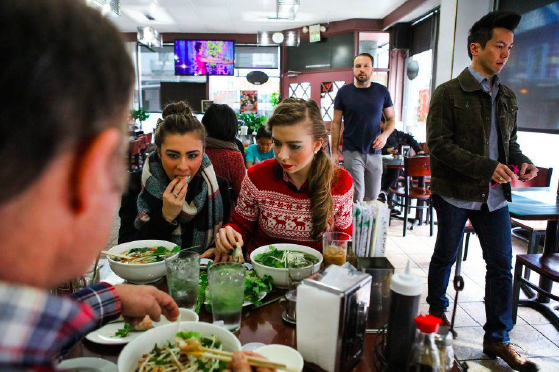
Ha Nam Ninh restaurant in San Francisco, California on Saturday, December 5, 2015 Source: Gabrielle Lurie, Special to The Chronicle
According to the information by San Francisco Chronicle 2015, the building owner refused to give them a reprieve from more than $20,000 of rent, citing ambiguous language in the lease. Lawsuits were threatened, lawyers got involved, and the restaurant, finally cowed, backed down and paid more than $30,000 in rent and fees. While, Ellis Larkin and its real estate broker did not respond to phone calls requesting comment. After the repairs were completed, Ha Nam Ninh reopened. Before one year when the time had come to negotiate the five-year lease extension, the property owners presented the restaurant owner with a new lease. The lease raised the rent by $1,000 a month in the first year alone, rising over the course of the next five years to $5,000 more a month, a 65 percent increase. So the restaurant owner refused to sign and the building owner is applying pressure. This is not only the story for Ha Nam Ninh or Sao Bien, but it is also very typical for other businesses in the ―Little Saigon‖ within the past two years. Anh Nguyen of TEDP said that after the businesses were forced to leave, many of the spaces are sitting vacant. Building owners let their properties languish in the hope that someone will pay prime rents — and even pay for structural repairs to boot. This situation causes many difficulties for small businesses and prevents the development of the ―Little Saigon‖ in particular and of
Tenderloin in general. Also Juan Carlos Cancino of the San Francisco Office of Economic and Workforce Development said, ―Neighborhood stakeholders have raised concerns that vacancies may no longer be the primary difficulty on Larkin — that it’s now about holding onto and getting the right business mix to support the neighborhood.‖ This is concerned the most difficulty for the business owners as well as for community organizations which are making efforts to leverage the Tenderloin economy. Unless the Government have the supports or interventions of the lease contract or lawsuit between building owner and businesses, one day the
―Little Saigon‖ has no more diversity of cuisines. At that time, people would not think of ―Little Saigon‖ when it comes to Vietnamese food or they know the ―Little Saigon‖ for something else, not regarding the Vietnamese. Would the name of ―Little Saigon‖ become meaningless? So People should think about that.
IV. The Tenderloin – Vietnamese community development projects
A. The Tenderloin development projects
There are many funds and grants from non-profit organizations which support the Tenderloin community such as $1 million from Tenderloin HIP last year for safety, healthy and strength of the community, $131,000 for more than 3,500 children living there, $100,000 for engage, stabilize and assist Tenderloin merchants and businesses, $50,000 for housing, education, employment, and health services.
According to Spencer Michels, a correspondent in San Francisco says that in future there are more tech enterprises moving to the next Tenderloin community, which brings with them well-paid white-collars who can afford to live in more upscale and pricey departments, bars and restaurants. A typical of example is Twitter, with 2,000 employees, recently opened its new headquarters just across the street from the Tenderloin. And that’s brought in a few new businesses and put pressure on the city to clean up the areas of the Tenderloin. However, the Tenderloin has not much change. It’s still not a pleasant place, but it is home for the homeless, the poor and drug dealers. ―Many other cities have had places like the Tenderloin, but they have redeveloped them. Somehow, the Tenderloin has resisted that‖, said Spencer Michels.
One of the reasons why the Tenderloin has not developed is due to the city’s experience in the largely African-American neighborhood called the Fillmore or Western Addition. In the 1960s, the city declared the area blighted and essentially bulldozed it into oblivion, forcing thousands of blacks to move out of the city called black removal. San Francisco magazine editor Gary Kamiya says that it was the greatest mistake in the history of San Francisco. Thus, many zoning laws and rent control were designed to keep the Tenderloin’s population by upgrading the housing stock, turning residential hotels into more lucrative tourist lodgings, and pricing out the poor, even in the midst of the nearby tech revolution. According to Randy Shaw, director of the Tenderloin Housing Clinic, a 100 year-old nonprofit in the neighborhood said that helped preserve a place where people could afford to live, the working poor included. These are a part of the solution, but ironically, they’re also part of the problem. The city is so loathed that other residents do not want to step in, while the homeless are coming here increasingly. The other reason but not least, there are not law enforcement issues. The police allow activities to go on in the Tenderloin they don’t allow in other neighborhoods. They don’t criminalize homelessness in San Francisco. According to Capt. Jason Cherniss, San Francisco Police Department says that the police are not in charge of public safety. Instead, it belongs to cooperation between the police and the community. If the environment is friendly with drug taking, removing that drug dealer is only going to take that one drug dealer off the street, but the environment still stands. So how do you clean up a drug-infested, crime-ridden area without displacing the unfortunate population that lives there?
It is not easy question but if the Government or community organizations want to upgrade the Tenderloin, they have to set up specific plans or development projects for the Tenderloin communities. So far there have been many positive development projects such as incentive program that levels up the community, attracting tech companies and new tech workers to step in. Some particular ones are listed out following, according to Ari Levy, CNBC’s senior technology reporter in San Francisco, 2015.
Any company with annual payroll expenses of at least $1 million that agreed to open on Market between Sixth and 11th streets (certain buildings were excluded) and some surrounding blocks would not have to pay tax on added payroll for six years. That’s real savings for fast-growing tech companies, potentially amounting to $56 million just for Twitter.
The tax incentive coupled with cheap and available space, certainly compared to other parts of the city, spurred a boom that continues today. Particularly, six companies—Twitter, Zendesk, Zoosk, Spotify, One Kings Lane and Microsoft’s Yammer—have signed community benefit agreements, or CBAs, outlining their planned volunteer, investing and philanthropic activities to give back to the community in order to qualify for tax breaks.
– The Better Market Street project (program to reconstruct the City’s premier cultural, civic and commercial corridor and the region’s most important transit street from Octavia
-Boulevard to The Embarcadero) has proposed a $400 million plan to improve transit and make the area bike and pedestrian friendly.
-Twitter’s projects include housing advocacy, education for kids, working with groups such as the Boys and Girls Club and SF Food Bank and $3 million in grants to nonprofits over the next four years. The company is opening a 4,000-square-foot facility called NeighborNest, a technology lab and teaching facility designed to help nonprofit groups educate their clients and prepare them for the workforce.
-Zendesk is recognized as an effective contributor to the community as the company provides grants and sends volunteers to senior centers, food banks, homeless facilities and job training programs. Additionally, its engineers built a mobile site in tandem with St. Anthony’s called Link-SF that helps the needy find nearby food, shelter and other services, because 40 percent of the nonprofit’s clients are using mobile technology.
-Even though Square, Uber and Dolby, on the market that don’t qualify for the tax break, they, too, are launching volunteer programs and encouraging civic activity among their workers.
-The Code Tenderloin project has been established by Seymour, an Army veteran and former drug addict who now works with numerous local nonprofits with the mission of connecting residents to businesses and offering work essentials like childcare, transportation and proper attire.
These projects contribute to ―community development‖ plans that one of which is to create jobs that are suitable for people who are from less fortunate environments and have lacked the skills and training required for technical positions. For the vision in future, such educational programs are a good preparation for the next generation of residents to work in technology and beyond. What tech companies have been doing move beyond charity that creates more chances for community member to become productive contributors. According to Benchmark’s Fenton, a venture capitalist says the dream scenario is that in 10 years, his firm is investing in “an entrepreneur who started his company in the Tenderloin, who grew up in the Tenderloin.‖ This is a quite possible vision when there were 11,000 employees, mostly in tech, have come to the area since 2011, according to data provided by the city.
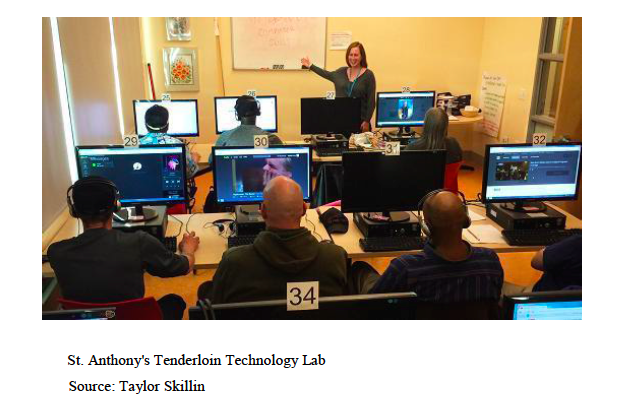
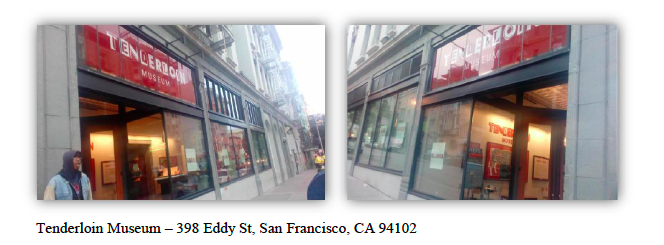
The museum is just built and opens on July 16, 2015 on the ground floor of the landmark Cadillac Hotel. The new born of Tenderloin Museum is a typical sample of the Tenderloin economic development.
B. The Tenderloin Vietnamese educational programs
On the other hand, John D. Dunbar, the author of ―The Bedrock of Community
Development,‖ Journal of Community Development Society 3‖ said that people play the main important role in community development, even much rather than economics. To achieve community development, it is concerned with growth of people, people’s knowledge, people’s skills, people’s involvement, people’s power to influence events and effect change in social and economic institutions, according to Kay Pell’s article, “The Role of OED in Community Development”. Also, Todd Rufo, director of the Office of Economic and Workforce Development said “We remain focused on creating a healthy, vibrant and economically diverse area in this neighborhood that serves all the residents of Central Market and the Tenderloin.” (CNBC, 2015)
Based on their discussions, it can be seen that the key word here is ―people‖. The challenge is to establish workplaces that attract prospects and comfort employees without sweeping away a diverse and largely low-income neighborhood. The highly recommendation is to set up educational programs that upgrades the Tenderloin communities’ skills and knowledge so that they can level up their income and get along with the lifestyle of tech co-workers coming here in future and other neighborhoods. There are currently some typical workshops, events and educational programs to support the local communities, and the Vietnamese included. The list of typical workshops and events as following:
| 1. Workshop Name of workshop – what | Small Business Growth in the Tenderloin |
| Date of workshop | 10/23/2015 |
| Time of workshop | 2pm |
| Location of workshop | Turtle Tower Restaurant |
| 645 Larkin St, San Francisco, CA 94109 | |
| Event coordinator | Anh Nguyen & her teams |
| Executive Director of TEDP | |
| Target audience – Who | New small business owners in the Tenderloin. |
| Speakers | Business lawyers |
| Banks (Well-Fargo) | |
| Insurance specialists | |
| Purpose of workshop | Make connections among business owners – |
| between business owners and potential workers | |
| Speakers give advices to audiences in terms of | |
| their major. | |
| Provide supports and information for audiences as | |
| well as lets audiences know about TEDP |
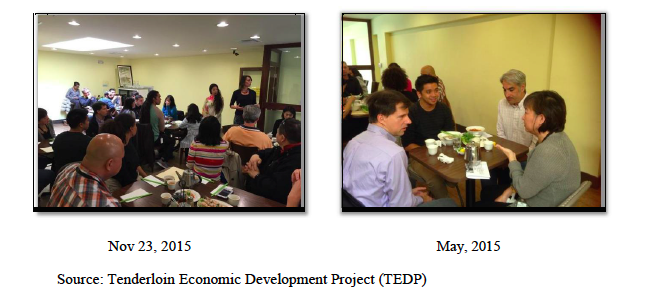
2. Community Meeting in Nov, 2015
Place: Ha Nam Ninh Restaurant – 701 Larkin St, San Francisco, CA 94109. The audiences: business owners in the Tenderloin
Host by TEDP – Anh Nguyen, executive director of TEDP
The message: Make connections, share experiences and update information.
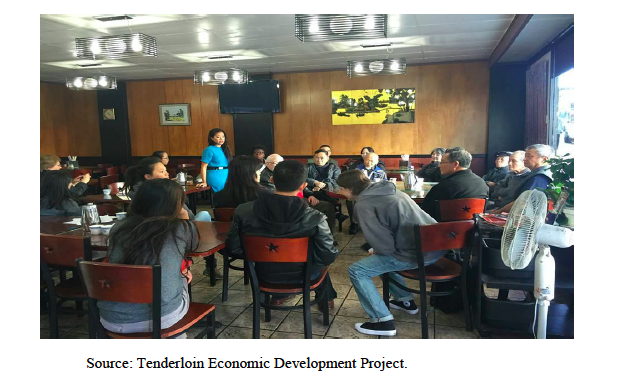
3. Kiva Zip program.
This is a small project run by Kiva.org that aims to ―expand financial opportunities and access for borrowers who otherwise lack them‖ and reduce the cost of capital for borrowers who are business owner in need with zero percent interest.
Based on the information published by hoodline.com, TEDP has helped 18 Tenderloin businesses run by immigrants and refugees navigate the fundraising process — which includes drafting a narrative in English to tell their story, completing Kiva Zip’s private fundraising period, which requires potential borrowers to secure contributions from 15 friends and family members ―to build credibility‖ before they can be listed on the public site, and vigorously marketing the businesses to reach their fundraising goals — plus many more are in the pipeline.
TEDP is working to build up the minority-owned businesses, but according to Anh Nguyen, executive director of the Tenderloin Economic Development Project, Vietnamese immigrant- and refugee-owned business owners lack cultural competency. Almost they are not good at English to take advantage of most city and non-profit services and technologies such as crowfunding platforms, credit card system and online catering dispatchers, which help them get more new customers, generate more revenue with the cut costs.
Another, they do not also recognize their friends moving out (the neighborhood’s demographics are changing). They just focus on serving their own communities instead of attracting new customer bases, like tech workers and tourists that could help them increase sales. With that in mind, their businesses are limited to extend to the prospective large scale. Last but not least, the Vietnamese community is afraid to join in community organizations. They are not likely to share their situations as well as to make connections. They are afraid to show people at what they are not good. They seemly avoid communicating with other communities or lack of communication skills. Therefore, not many Vietnamese people participate in workshops and events in the Tenderloin.
Furthermore, almost Vietnamese community centers such as Vietnamese Youth Development Center and Southeast Asian Community Center are so small that few people pay them attention. They lack of facilities and exciting workshops, even look very old. Their activities are limited to the youth or the elderly without for business owners or adults. Most of their projects are English education for only the youth under 18 years old and help people find a hiring job. Some are for only the elderly or retired including language translation service.
To upgrade the Tenderloin Vietnamese community, the largest minority community in Tenderloin, the Government or other non-profit organizations had better give more funds to Vietnamese centers in order to leverage their diversity of education programs or workshops.
Moreover, the facilities here need to be upgraded to serve the community better. According to the survey, many Vietnamese know these community centers, but they are very rarely to come there to find the supports because they assume that the centers are not able to help or satisfy their need.
However, among are some successful people who are attributed to participate often in workshops and supporting programs by the Tenderloin community.
V. The Tenderloin Vietnamese – Chinese culture
The tenderloin in San Francisco has often been referred to as “Little Saigon.” The city recently recognized the two-block corridor of Larkin Street between Eddy and O’Farrell streets as Little Saigon. The street has been boosting the area’s reputation as a Vietnamese cultural and commercial center and will attract visitors, especially tourists. According to Phu Nguyen, task force member and commissioner of San Francisco’s Immigrant Rights Commission, “Little Saigon‖ is a home of the Vietnamese in San Francisco due to the concentration of Vietnamese – owned businesses, particularly Vietnamese cuisine. Vietnamese cultural celebrations have also been held in the Tenderloin for years. The Tet Festival, the Vietnamese Lunar New Year celebration, drew more about 20,000 people to the neighborhood in mid-January with exciting activities such as entertainment, food, games, dance, and more. This is a point of interest for tourists in every San Francisco tour. There is a pair of dragons sitting atop stone pillars greet visitors crossing the neighborhood’s official threshold at Larkin and Eddy Streets. But
Vietnamese culture in the neighborhood isn’t limited to Little Saigon’s technical boundaries.
Moreover, there are some green-and-yellow banners emblazoned with “Sai Gon Nho” and its English translation, “Little Saigon,” have gone up on Larkin Street. (The name refers to the capital of the former South Vietnam, renamed Ho Chi Minh City at the end of the Vietnam War.) The banner, designed by architect Ben Thanh, features a painting of a French Colonial open market built in Saigon in the early 1900s. Twenty banners made through a design competition sponsored by the North of Market/Tenderloin Community Benefit District went up Monday along the Larkin Street corridor between McAllister and Geary streets. Six designers submitted banner artwork, with Collison’s winning the approval of merchants and residents in the area. The design has a dragon motif and includes a drawing of a famous Vietnamese marketplace building.
He said his design goals were to ―celebrate the Vietnamese community and be attractive for Little Saigon.‖ The picture as following shows some activities in the Vietnamese Tet Festival.
The writing of my research is currently in progress
Written by: My Thuy Ngoc
Mentor: Thanh Ngo
San Francisco, March 2015